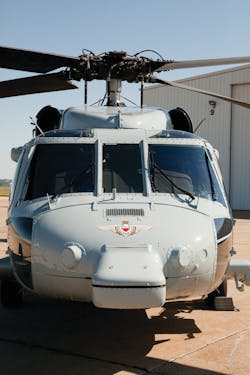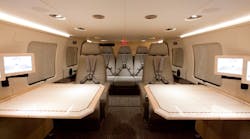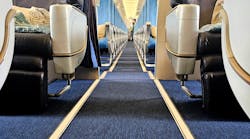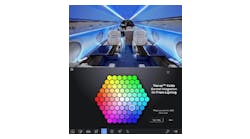Maneuverability, capacity, speed – all the elements that make a helicopter like the UH-60 Blackhawk an excellent choice for military service seem to make it the right choice for VVIP transport as well. Nimble and agile, the Blackhawk is able to perform in a wide variety of conditions, and the generous interior has room for 11 fully equipped infantry soldiers. The form and function that make it perfect for a fight also make the Blackhawk a perfect fit for a VIP seeking an efficient and comfortable way to travel.
"The Blackhawk airframe meets both the security and tactical needs of these clients, and Sabreliner's custom interiors provide the level of quality and luxury expected by this audience," says Tracy Ogle, Sabreliner Corporation's vice president of helicopter services.
Veterans serving together
Sabreliner Corporation of St. Louis, MO, and the Blackhawk are both veterans with long histories of service. When Sabreliner was asked to turn Blackhawk helicopters into head-of-state aircraft, it embraced the challenge. The project was appropriate for the company whose own roots were in the transformation of the Air Force T-39 military trainer into the Sabreliner fleet of business jets. Like the Blackhawk, the T-39 was built to military specifications for strength, performance, and flying qualities, including the ability to stand up to 4G maneuvers. Those same high standards were incorporated into the world's first twin-engine business jet, the Sabreliner Model 40. Sabreliner ultimately built more than 400 business jets, and it has recently completed 11 Blackhawk helicopter VIP interiors for both the United States and allied nations.
Additionally, Sabreliner has performed numerous 500-hour phase inspections on the Blackhawks. The inspection involves the complete teardown of the aircraft including the removal of all components and then detailed inspection of flight critical components is conducted. Components are repaired, replaced, or reinstalled as needed. The aircraft then undergoes rigging checks, electrical/avionics checkouts, and a flight test.
"Findings during the inspection largely depend on the environment the aircraft is operated in," says Ogle. "But it's a very solid airframe."
Per Sikorsky, the Blackhawk's OEM, the UH-60M helicopter culminates more than 30 years of technological advancement, improved performance, and real-world experience. The U.S. Army began using the aircraft in 1979 as a replacement for the UH-1 Huey to provide air assault, general support, aeromedical evacuation, command and control, and special operations support to combat and stability and support operations. The aircraft's critical components and systems are armored or redundant, and its airframe is designed to progressively crush on impact to protect the crew and passengers.
From warship to cruise ship
The functionality of the Blackhawk helicopter along with Sabreliner's engineering, interior design, and fabrication expertise have proved to be a winning combination for clients seeking a helicopter with a VVIP configuration.
Earlier this year, Sabreliner delivered two highly modified UH-60M Blackhawk helicopters to the Royal Jordanian Air Force for use by Jordan's royal family. The aircraft feature a Sabreliner-developed executive entry system and complete cabin entertainment systems. The two Jordanian aircraft incorporate cabin systems that display moving map, iPod content, and DVDs on both individual and 17-inch cabin-mounted monitors. An iridium phone system allows conference calling.
The Jordanian aircraft also feature a Sabreliner-developed modification used in all of its Blackhawk completions – a frame-load isolation design which allows the combat-proven helicopters to be converted for VVIP use. The proprietary isolation system restricts movement in the forward/aft and left/right axis while allowing no vertical loads, increasing airframe life.
Sabreliner also created executive entry clamshell doors with integrated steps. The door design maximizes the space in the cabin for executive seating and allows for more work surfaces. The plug for the existing door was designed to sustain the vertical loads applied to the aircraft and it floats up to 1 inch during flight.
"The most significant challenge of the completions was designing, engineering, and installing the clamshell door and the door plug," says Ogle. "The mods had to maintain the reliability of the aircraft structure, which they did. Other than the added weight, the helicopter acts like it doesn't know the modified door is there."
The idea for the clamshell door was born when a long-time customer approached Sabreliner for options for replacing their existing hinge-style door and rigid plugs which were facing structural obsolescence. In response, Sabreliner developed the clamshell design which features increased, more efficient room in the cabin and improved aerodynamics.
"Because the door is hinged at the top and bottom and opens in the middle like a clamshell, it accommodates the flexing of the aircraft better, and it fits the contours of the fuselage better. It's more aerodynamic than the original door," says Ogle.
Sabreliner performed 100 percent of the design, engineering, structural analysis, and manufacturing required for the helicopter completions, meeting OEM, FAA, and military standards, with the most stringent standard applied when the three sources varied. The completed helicopters went through an airworthiness release process through the office of the U.S. Army's engineering director.
Other aircraft modifications were made during the completions process including addition of forward-looking radar, TCAS, environmental control units, and modification of the defensive systems. All of the mods required approval through the same rigorous review process.
Interior furnishings also were designed, fabricated, and installed by Sabreliner. In some cases, interiors were designed to match a client's other fixed wing assets. In others, Sabreliner and the client worked from a clean slate.
Interior options encompassed a broad range of potential upgrades, catering both to luxury and functionality, and were designed to meet the specific requests of the clients. Customer-driven choices were made at every level of detail – fabrics, colors, shapes, sizes, stitching, foam density, and more.
"We presented designs and renderings that took advantage of all the available real estate in the cabin," says Ogle. "Color boards and fabric samples were provided along with renderings so that clients could visualize the finished product."
Email, teleconferences, and visits were used to keep in touch with customers, especially those half a world away. Once materials were selected, Sabreliner's upholstery technicians fabricated the cabin seating. Cabin electrical and avionics teams performed the cabin and cockpit system upgrades.
Sabreliner designed the internal communication system used in the VVIP helicopter interiors as well. The system allows passengers to speak to each other and to the crew. A satellite phone can be tied into the system allowing teleconferencing of multiple users both in the air and on the ground while in flight.
Computer numerical controlled (CNC) manufacturing allowed for creating specific milled parts in-house including supports, fittings, and laminates. Sleek composite side panel modifications added space and reduced total aircraft weight. The aircraft were painted by Sabreliner as well.
An average completion takes from four to six months, depending on the materials and modifications selected. Helicopter support including the 500-hour phase inspection also can be performed in the field. Sabreliner is readying a field team for a project in Bahrain, and it provides ongoing support to helicopters based in Saudi Arabia and Jordan.
From Perryville to Petra
How did the completed Jordanian helicopters get to their new homes? They rode in style in the cargo hold of a C-17 aircraft. Sabreliner officials accompanied the helicopters to their new home and were honored by a large welcoming committee.
The Sabreliner crew also designed and installed VIP interiors in a fleet of Blackhawks used in and around the Washington, D.C., metropolitan district for senior military staff, the directors of the CIA and FBI, and elected officials.
All of the completion aircraft were worked on at Sabreliner's Perryville, MO, operation located 90 miles south of St. Louis. The complex comprises a dozen buildings with more than 200,000 square feet under roof. It is the company's largest and most comprehensive maintenance, repair and paint facility.
Perryville is the birthplace for a generation of Sabreliner business jets, but today the complex bustles with work on a wide variety of aircraft, ranging from the Blackhawk helicopters to U.S. Air Force C-21 Learjets, from propeller-driven PC-12, T-34 and T-44 trainers flown by U.S. Navy, Coast Guard, and Marine pilot candidates, to Vietnam-era A-4 Skyhawk attack aircraft which were stored for decades in the desert before being carefully restored to flying condition by Sabreliner's technicians.
"We perform design, manufacturing, integration, and delivery services for a wide variety of aircraft," says Ogle. "With all the resources we have in-house plus our talented team, we're a one-stop shop."





